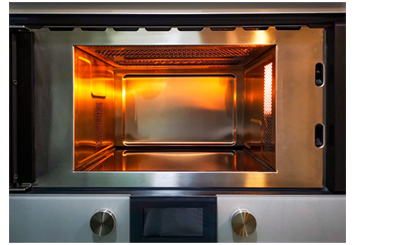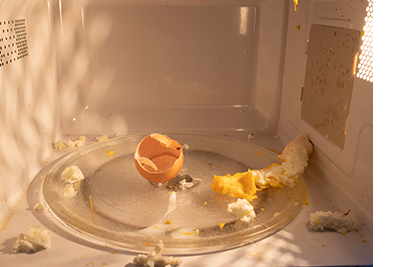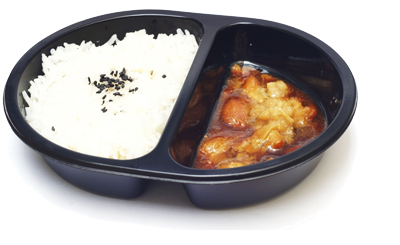When it comes to reheating, defrosting, cooking, or melting, a commercial-grade microwave is a necessity in any busy kitchen. This appliance is the forgotten saviour as it doesn’t require pre-heating to get the job done. They’re also compact and easy to use without the need for expert installation. There’s also the bonus that they don’t add heat to your kitchen when they’re in use. So what is a microwave and what is it used for? Does it still have a place in commercial kitchens? We give you all the answers you need in the following article.
How do microwave ovens work?
Microwave ovens use non-ionizing radiation via an electron tube called a magnetron. This surge of energy is absorbed by the food causing the water molecules in it to vibrate ferociously creating heat that warms, defrosts, or cooks the food. When defrosting or cooking commences, the magnetron takes the electricity and converts it into radio waves.
 The radio waves (or microwaves) bounce around the compartment, like light bouncing off a mirror, but when they heat the food they don’t bounce off. They penetrate the food delivering energy to the molecules inside causing those molecules to vibrate ferociously creating heat. Water molecules are most susceptible to these radio waves which explains why food can dry quickly when cooked in a microwave.
The radio waves (or microwaves) bounce around the compartment, like light bouncing off a mirror, but when they heat the food they don’t bounce off. They penetrate the food delivering energy to the molecules inside causing those molecules to vibrate ferociously creating heat. Water molecules are most susceptible to these radio waves which explains why food can dry quickly when cooked in a microwave.
As a result, microwave ovens don’t brown or single food. This means they won’t produce the flavourful chemical reactions obtained when frying, browning, or baking, but they are superior when it comes to defrosting or heating food in a very short time.
The difference between commercial and domestic microwaves
Magnetrons & turntables
The first obvious difference between a commercial microwave is the absence of a glass turntable featured in domestic models. Commercial microwaves feature a flat ceramic base that does not limit dish size, is easy to clean, and is not susceptible to breaking.
How is it possible to have a microwave without a rotating turntable? In domestic microwaves, there is one heat source so the food needs to rotate for the heat source to be distributed. This is the reason it is not recommended to place food in the centre of a domestic microwave but rather off-centre.
In commercial microwaves, there are multiple magnetrons heating more areas of the microwave. They bounce off the interior coating like a pinball until they’re absorbed by the food that is heating.
Power, longevity & cost
Commercial microwaves are designed with heavy-duty components suitable for larger workloads over longer periods. They’re designed for constant usage throughout the day whereas domestic microwaves are designed for limited use. While a domestic microwave may seem like an affordable piece of equipment for a café or food van, this is not necessarily the case. The number of times a domestic microwave used in a commercial setting will need repair or replacement will quickly outweigh the cost of investing in a suitable microwave for your business.
Speed & convenience
Commercial microwave ovens have far greater power outputs than domestic microwave ovens. For example, a commercial microwave oven can have an output of 1900W compared to a domestic model with an output of 700-900W. This means heating times can be reduced significantly with a commercial oven.
Related: Read our article about Watts, Volts & Amps
Another advantage of commercial microwave ovens is the programmable menu options. You’re able to program cooking or heating times for specific menu items. This is an underestimated though time-saving feature that is appreciated in busy kitchens and it ensures consistency.
Does a microwave heat from the inside out?
In a conventional oven, there are heating elements in the bottom or sides of the cooker providing heat to food from the outside in. Many advisors say that microwaves counter this by cooking from the inside out. That is not correct. Microwaves stimulate molecules within the food at once and there a numerous heating points depending on where the reactive molecules are situated.
How food cooks in a microwave are dependent on what it is made of and where it is situated in the oven. If you place a meat pie in a microwave for 3 minutes, it may be perfectly heated. However, place an apple pie of the same size in the oven for 3 minutes and you’ll find the inner fruit scolding as they contain more active molecules reacting to the radio waves. A slice of steak the same size will be barely beyond rare when cooked for the same period due to its density. The outside may appear cooked but the inside will certainly be raw and inedible.
 Consider the radiowaves produced in microwaves to be like swimmers diving into the water. The denser the food, the harder they need to swim and the more energy they lose in the outer layers. The more fluid the food, the quicker it can swim through it without losing energy.
Consider the radiowaves produced in microwaves to be like swimmers diving into the water. The denser the food, the harder they need to swim and the more energy they lose in the outer layers. The more fluid the food, the quicker it can swim through it without losing energy.
It’s a common occurrence when meals are cooked in microwaves without this understanding for things to go wrong. It is easy for meals to end up cooked on the outside and uncooked in the middle, overdone on the outside and cooked beautifully in the middle, or dried up to the point of inedible within just a few minutes.
How do pre-cooked and packaged microwave meals work?

You’ll notice the frozen meals purchased from supermarkets that are designed for microwaves recommend a specific cooking time that is always followed by a standing time. This is because once the food is heated, the hotter parts of the food pass on the heat via conduction to the cooler parts, sharing the heat amongst the meal. The way microwaves distribute heat is unique as the heat isn’t distributed evenly from one point of contact to the next. It is blasted at a high level to susceptible points and that heat then radiates throughout the rest of the food source.
Reward Hospitality has the microwave you need
It can be a tricky business identifying the microwave you need. Is it the capacity you’re looking for or should the power output be the determining factor? Take the hassle out of shopping for your microwave and let us help.
Browse our catalogue where you’ll find an array of microwaves on display. We have a team of equipment experts on standby to offer advice and answer your questions. Give us a call, start an online chat, or arrange for one of our equipment specialists to visit you in person to get the ball rolling. Reward Hospitality can help you select the right equipment for your needs.